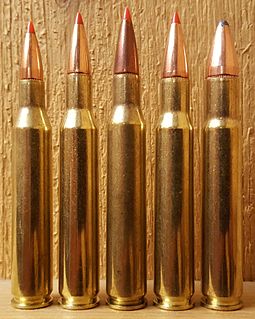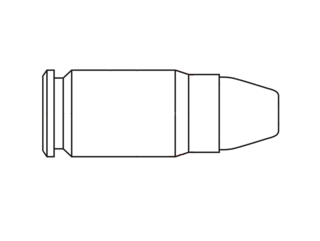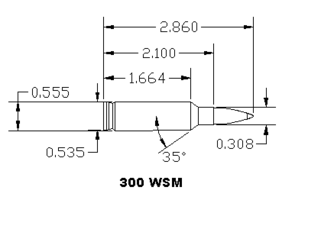Related Research Articles

The .40 S&W is a rimless pistol cartridge developed jointly by major American firearms manufacturers Smith & Wesson and Winchester. The .40 S&W was developed from the ground up as a law enforcement cartridge designed to duplicate performance of the Federal Bureau of Investigation's (FBI) reduced-velocity 10mm Auto cartridge which could be retrofitted into medium-frame semi-automatic handguns. It uses 0.40-inch (10 mm) diameter bullets ranging in weight from 105 to 200 grains.

The .45 ACP or .45 Auto (11.43×23mm) is a rimless straight-walled handgun cartridge designed by John Moses Browning in 1904, for use in his prototype Colt semi-automatic pistol. After successful military trials, it was adopted as the standard chambering for Colt's M1911 pistol. The round was developed due to a lack of stopping power in Sulu experienced in the Moro Rebellion using the .38 Long Colt. This experience and the Thompson–LaGarde Tests of 1904 led the Army and the Cavalry to decide a minimum of .45 caliber was required in a new handgun.

The .45 GAP or .45 Glock (11.43×19mm) is a pistol cartridge designed by Ernest Durham, an engineer with CCI/Speer, at the request of firearms manufacturer Glock to provide a cartridge that would equal the power of the .45 ACP, have a stronger case head to reduce the possibility of case neck blowouts, and be shorter to fit in a more compact handgun. The .45 GAP is the first commercially introduced cartridge that has been identified with Glock.

The 38 Super, also known as 38 Superauto, 38 Super Auto, or 9×23mmSR, is a pistol cartridge that fires a 0.356-inch-diameter (9.04 mm) bullet. It was introduced in the late 1920s as a higher pressure loading of the 38 ACP, also known as 38 Auto. The older 38 ACP cartridge propels a 130-grain (8.4 g) bullet at 1,050 ft/s (320.0 m/s), whereas the 38 Super pushes the same bullet at 1,280 ft/s (390.1 m/s). The 38 Super has gained distinction as the caliber of choice for many top practical shooting competitors; it remains one of the dominant calibers in IPSC competition.

The .338 Lapua Magnum is a rimless, bottlenecked, centerfire rifle cartridge. It was developed during the 1980s as a high-powered, long-range cartridge for military snipers. It was used in the War in Afghanistan and the Iraq War. As a result of this, it became widely available.

The .45 Colt (11.43×33mmR), is a rimmed, straight-walled, handgun cartridge dating to 1872. It was originally a black-powder revolver round developed for the Colt Single Action Army revolver. This cartridge was adopted by the U.S. Army in 1873 and served as an official US military handgun cartridge for 14 years.

A wildcat cartridge, often shortened to wildcat, is a custom cartridge for which ammunition and/or firearms are not mass-produced. These cartridges are often created in order to optimize a certain performance characteristic of an existing commercial cartridge.

The .270 Winchester is a rifle cartridge developed by Winchester Repeating Arms Company in 1923 and unveiled in 1925 as a chambering for their bolt-action Model 54. The cartridge is the same length as the .280 Remington, both of which are longer than the .30-06 Springfield. The .270, .280, and .30-06 were all derived from the .30-03 parent case and the bore diameter was likely inspired by 7mm Mauser. The .270 Winchester uses a .270 inch (6.86 mm) bore diameter and a .277 inch (7.04 mm) bullet diameter.
A rim is an external flange that is machined, cast, molded, stamped, or pressed around the bottom of a firearms cartridge. Thus, rimmed cartridges are sometimes called "flanged" cartridges. Almost all cartridges feature an extractor or headspacing rim, in spite of the fact that some cartridges are known as "rimless cartridges". The rim may serve a number of purposes, including providing a lip for the extractor to engage, and sometimes serving to headspace the cartridge.

The .38 ACP, also known as the .38 Auto or 9x23mmSR, is a semi-rimmed pistol cartridge that was introduced at the turn of the 20th century for the John Browning-designed Colt M1900. It was first used in Colt's Model 1897 prototype, which he did not produce. The metric designation for the round is 9×23mm SR (semi-rimmed), which is not to be confused with other 9×23mm cartridges.
Snake shot refers to handgun and rifle cartridges loaded with small lead shot. Snake shot is generally used for shooting snakes, rodents, birds, and other pests at very close range. The most common snake shot cartridge is .22 Long Rifle loaded with No. 12 shot. From a standard rifle these can produce effective patterns only to a distance of about 3 metres (10 ft), but in a smoothbore shotgun that can extend as far as 15 metres (50 ft).

The .50 GI (12.7×23mmRB) pistol cartridge was developed by Alex Zimmermann of Guncrafter Industries. The .50 GI was introduced at the 2004 SHOT Show alongside the Guncrafter Industries Model No. 1, a variation of the M1911. The round has a rebated rim that is the same diameter as that of the .45 ACP.

Overpressure ammunition, commonly designated as +P or +P+, is small arms ammunition that has been loaded to produce a higher internal pressure when fired than is standard for ammunition of its caliber, but less than the pressures generated by a proof round. This is done typically to produce rounds with a higher muzzle velocity and stopping power, such as ammunition used for defensive purposes. Because of this, +P ammunition is typically found in handgun calibers which might be used for defensive purposes.

The .32 NAA is a cartridge/firearm 'system' designed and developed by the partnership of North American Arms and Corbon Ammunition. The cartridge is a .380 ACP case necked-down to hold a .32 caliber bullet with the goal of improved ballistic performance over the .32 ACP.

300 Winchester Short Magnum is a .30 caliber rebated rim bottlenecked centerfire short magnum cartridge that was introduced in 2001 by Winchester.

The .41 Action Express is a pistol cartridge developed in 1986 to reproduce the performance of the .41 Magnum police load in semi-automatic pistols.
The .45 Super is a powerful smokeless powder center fire metallic firearm cartridge developed in 1988 by Dean Grennell, a well-known writer in the firearms field as well as managing editor of Gun World magazine. It is dimensionally similar to the .45 ACP round but has a thicker case wall and is loaded to higher pressures, which offers an average 300 feet per second (91 m/s) improvement in muzzle velocity over the .45 ACP. The cartridge was co-developed by Tom Fergerson and Ace Hindman.
The .40 Super is a powerful automatic pistol cartridge developed in 1996 and introduced to the market by Triton Cartridge. The cartridge was co-developed by Fernando Coelho and Tom Burczynski.
References
- ↑ "Gun Review: The Detonics Story - The Firearm Blog". The Firearm Blog. 2015-06-24. Retrieved 2017-06-15.